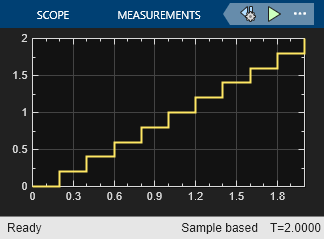Digital Clock
Producir como salida el tiempo de simulación en un intervalo de muestreo especificado
Bibliotecas:
Simulink /
Sources
Descripción
El bloque Digital Clock produce como salida el tiempo de simulación solo en el intervalo de muestreo especificado. En otros tiempos, el bloque mantiene el valor anterior de la salida. Para controlar la precisión de este bloque, utilice el parámetro Sample time en el cuadro de diálogo del bloque.
Utilice este bloque en lugar del bloque Clock, que produce un tiempo continuo como salida, cuando necesite el tiempo de simulación actual dentro de un sistema discreto.
Ejemplos
Puertos
Salida
Parámetros
Características del bloque
Tipos de datos |
|
Paso directo |
|
Señales multidimensionales |
|
Señales de tamaño variable |
|
Detección de cruce por cero |
|
Capacidades ampliadas
Historial de versiones
Introducido antes de R2006a

